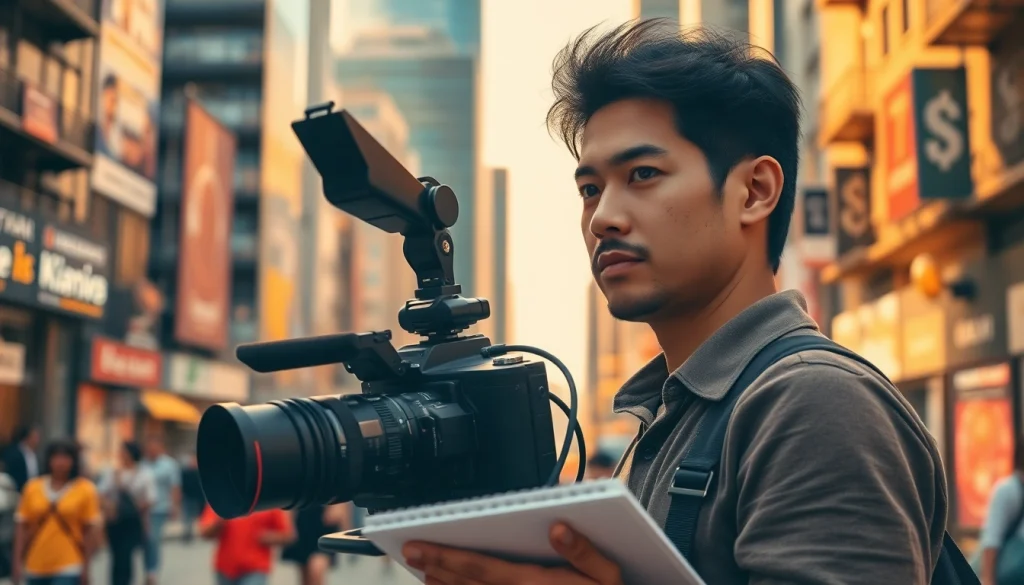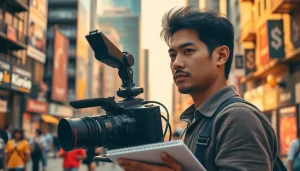Crafting Impactful Narratives: The Art of Stories & Documentaries

Understanding the Role of Stories & Documentaries
In the digital age, the importance of Stories & Documentaries is more pronounced than ever. They not only entertain but also educate, inspire, and provide a lens through which we can understand the complexities of the human experience. As storytelling evolves with technology, the role of documentaries becomes more significant, serving as powerful tools for engagement and advocacy.
The Importance of Authentic Narratives
The heart of any compelling story lies in its authenticity. Authentic narratives resonate with viewers, evoking empathy and fostering connections. Documentaries rooted in real-life experiences often deliver a profound impact by portraying the triumphs and struggles of individuals or communities. They break down preconceived notions and challenge societal norms.
For instance, a documentary focused on a marginalized community can shed light on their challenges, encouraging viewers to engage with the subject matter on a personal level. By presenting stories that might otherwise remain untold, filmmakers not only empower those voices but also invite audiences to participate in the conversation.
How Documentaries Influence Society
Documentaries play a crucial role in shaping public opinion and cultural discourse. Through the factual portrayal of events or issues, they can educate audiences on critical social, political, and environmental matters. For example, films addressing climate change have mobilized communities, spurring action and advocacy in ways that traditional media often fails to achieve.
Moreover, documentaries like “13th,” which explores the history of racial inequality in the United States, provoke discussions that result in real-world implications, including policy changes and increased activism. These narratives hold the power to ignite social movements and inspire collective efforts towards change.
Elements of Compelling Stories
Effective storytelling in documentaries involves several key elements that enhance viewer engagement:
- Character Development: Audiences must connect with the characters emotionally. Well-rounded protagonists and antagonists create relatable narratives.
- Conflict: Central conflict drives narratives. Whether it’s an internal struggle, societal issue, or an external antagonist, conflict keeps viewers invested in the outcome.
- Resolution: While not every story has a happy ending, a well-defined resolution gives closure to viewers and emphasizes the documentary’s message.
- Visual Storytelling: Visual elements complement narrative arcs. Cinematic techniques, such as using close-ups or drones for breathtaking panoramas, can elevate storytelling.
- Authentic Voice: The narrator’s voice, be it the filmmaker or a central character, should convey passion and sincerity, drawing viewers into the story.
Techniques for Effective Storytelling in Documentaries
Visual Techniques to Enhance Narratives
Visual storytelling is paramount in documentaries. Effective use of cinematography and editing can heighten emotional resonance and clarify complex ideas. Techniques such as using natural light enhance authenticity, while detailed shots can evoke empathy towards subjects.
Documentarians might employ various framing techniques to emphasize emotional cues. For instance, a close-up shot of a subject’s face during an emotional moment captures the intensity and draws viewers into that experience. Similarly, contrasting wide shots can illustrate the scale of a problem or setting.
Audio Elements that Complement Storytelling
Sound design significantly influences a viewer’s emotional experience. The careful selection of background music, ambient sounds, and interviews can create a powerful atmosphere. Well-placed audio cues help in building tension or providing relief, guiding audiences through the documentary’s emotional landscape.
For example, documentary filmmakers often layer soundscapes to evoke certain feelings, utilizing silence in pivotal moments to emphasize impact. Narration should also align with the visual narrative, reinforcing key messages while maintaining the documentary’s pacing.
Editing for Emotional Impact
Editing shapes the rhythm and flow of a documentary. The power of storytelling lies in how events are sequenced and juxtaposed. Editors must make strategic choices about pacing—quick cuts can create tension, while longer takes can allow for reflection. The art of editing is about finding the balance between these approaches to maintain viewer engagement.
Moreover, employing techniques such as montages can condense time and highlight themes, allowing audiences to grasp the narrative’s essence quickly. A poignant montage juxtaposing joyful memories with somber realities can leave a lasting impression on viewers, often catalyzing deeper contemplation of the subject matter.
Exploring Different Genres of Stories & Documentaries
The Diversity of Documentary Forms
Documentaries can span various genres, from biographical and historical to nature and investigative. Each form offers unique storytelling possibilities and thematic explorations:
- Biographical Documentaries: These focus on the life of an individual, providing insight into their experiences, motivations, and influence. Notable examples include “Jiro Dreams of Sushi,” which chronicles the life of a sushi master.
- Historical Documentaries: They provide context and examine the significance of past events, illustrating how they shape the present. “The Fog of War” is a remarkable examination of U.S. wartime strategy through the lens of a former Secretary of Defense.
- Nature Documentaries: These showcase the beauty and complexity of the natural world. “Planet Earth” and “Our Planet” have captured imaginations worldwide, highlighting both the splendor and fragility of our ecosystems.
- Investigative Documentaries: Designed to unveil hidden truths or societal issues, these often involve extensive research and often provoke discussion or action. “The Act of Killing” challenges filmmakers to confront their subjects’ roles in genocide.
How Genres Shape Audience Perception
Genres greatly influence how stories are perceived and received by audiences. Different formats and styles can prime viewers to engage with content in specific ways. For instance, an investigative documentary may create a sense of urgency and provoke critical thinking, whereas a biographical documentary might foster empathy.
Effective filmmakers strategically choose genres to communicate their message. By curating the documentary’s style, they can evoke desired emotional responses, which can ultimately enhance viewer retention and advocacy for the cause presented.
Case Studies of Notable Documentaries
Studying successful documentaries can provide invaluable insights into effective storytelling techniques. Consider “Our Planet,” a collaboration between Netflix and conservationists, which uses stunning visuals and poignant narratives to advocate for environmental protection. The film’s ability to blend spectacular cinematography with a compelling narrative has made it influential in conservation efforts.
Another notable example is “Won’t You Be My Neighbor?” This biographical documentary about Fred Rogers evokes nostalgia while addressing critical themes of kindness and empathy. Its emotional resonance stems from carefully curated interviews and iconic clips that connect Rogers’ philosophy with contemporary issues.
Challenges in Creating Stories & Documentaries
Balancing Artistic Vision and Audience Engagement
Documentary filmmakers often grapple with the challenge of balancing their artistic vision with the need for audience engagement. The creative process can sometimes lead to decisions that overly favor artistic expression over clarity and accessibility. This balance is vital; a documentary that fails to connect with its audience risks obscuring its message.
Succeeding in this endeavor requires continual audience feedback and testing. Filmmakers should strive to understand their target audience’s preferences, tailoring content without compromising their original intent. Engaging viewers in the storytelling process, whether through social media or focus groups, can yield valuable insights.
Ethical Considerations in Documentary Filmmaking
Ethics play a crucial role in documentary filmmaking. Ensuring the accuracy of representation, gaining consent from participants, and maintaining transparency regarding potential biases are essential components of ethical storytelling. Documentaries often navigate sensitive topics, requiring filmmakers to be compassionate and conscientious.
Engaging with communities respectfully and accurately is essential. Filmmakers must avoid exploiting their subjects, ensuring that their stories are told authentically and holistically. Moreover, there should be accountability regarding how subjects are portrayed, especially in contentious narratives.
Technical Barriers in Production
Documentary filmmaking, like any cinematic endeavor, poses technical challenges. Budget constraints can limit resources, while access to subjects can also affect the scope of a project. Emerging technologies, such as drones and virtual reality, offer new possibilities but often come with high costs.
Successful documentary makers often need to employ creativity and resourcefulness. Leveraging partnerships, using public domain resources, and crowdfunding can help mitigate financial constraints. Additionally, thorough planning and pre-production research can ensure that production runs smoothly, overcoming logistical hurdles.
Future Trends in Stories & Documentaries
The Rise of Interactive Documentaries
As technology evolves, the line between passive viewing and interactive engagement is blurred. Interactive documentaries engage audiences by allowing them to participate actively in the narrative experience. By incorporating user-generated content, branching storylines, or augmented reality elements, filmmakers can foster deeper viewer connections.
Notable examples include “The Invisible Man,” an interactive documentary exploring the lives of undocumented immigrants. Such formats invite viewers to explore different perspectives, offering a richly layered understanding of the narrative context.
Impact of Streaming Services on Documentary Popularity
Streaming platforms have revolutionized access to documentaries, creating wider audiences and promoting varied voices. Through curated collections, viewers can discover niche genres and underrepresented narratives. Services are launching dedicated documentary channels, reflecting the growing demand for such content.
As more documentaries gain traction on mainstream platforms, filmmakers have increased motivation to produce quality content. The proliferation of various genres democratizes storytelling, resulting in a richer tapestry of narratives available to audiences worldwide.
Emerging Technologies in Filmmaking
Innovations in technology are continually reshaping documentary filmmaking. Cutting-edge camera technology allows for high-quality visuals in challenging environments, while AI tools can streamline editing and enhance storytelling processes. Virtual reality and augmented reality create immersive experiences, enabling audiences to step into the narrative.
As filmmakers embrace these emerging technologies, they have the opportunity to push boundaries and create compelling narratives that resonate more profoundly with viewers. Keeping up with technological advancements can redefine documentary filmmaking and expand its artistic expression.







